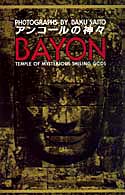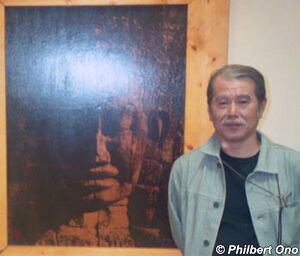BAKU Saito
BAKU Saito BAKU 斎藤 (1948– ) Niigata Pref.
Entered Osaka Art School in 1966. Entered Forme Art Paintings Laboratory in 1968. Started working at New Photo Studio in 1970. Studied under photographer MIYASHITA Akiyoshi. Became a freelance commercial photographer in 1980. Established STUDIO BAKU Inc. in 1985. Specializes in Angkor Wat in Cambodia.
Bayon - Temple of Mysterious Smiling Gods アンコールの神々
Reviewed on: Dec. 12, 2000 Last modified: 2005-04-03 Exquisite photos of the faces and figures carved on this magnificent temple in Angkor, Cambodia.
世界遺産のアンコールの女神たちの笑顔。写真家は頻繁にアンコールへ旅立っている。
Published: Oct. 1, 1997 Publisher: Shogakukan ISBN: 4096810118 Price in Japan: ¥5,040 Qualities: Hard cover, color and B/W photos Size: Oversize, 88 pp. Language: Japanese and English
Cambodia's Angkor area is home to one of the world's greatest man-made structures, on par with Egypt's pyramids, Greece's Acropolis, and India's Taj Mahal. Angkor was where the country's kings ruled during Cambodia's Angkor Period from 802 to 1431. Usually when there was a new king, a new temple-palace was built in the area. Angkor has been dotted with temples and monuments since about a millennium ago. The most famous of course is Angkor Wat which was built as a Hindu temple. About one kilometer north of Angkor Wat is Angkor Thom, another temple-palace city completed in the late 12th century, less than a century after Angkor Wat.
Angkor Thom was built by King Jayavarman VII who was a prolific builder of temples, monuments, and hospitals during his reign from 1181 to 1215. After defeating the invading Chams based in southern Vietnam and annexing their Champa Empire, he founded the greatest empire in the history of Southeast Asia.
Angkor Thom is a geometric and quadrangular city, bordered by a 100-meter moat and high wall. It is 10 square kilometers in area. It is Angkor's second most famous attraction after Angkor Wat. At the exact center of Angkor Thom is the colossal Bayon temple, the subject of this photo book.
 Bayon has a square configuration, with each side measuring about 150 meters. It is a temple made of countless blocks of stone with huge and intricate carvings. There are over 50 towers with carvings of huge faces (with a Mona Lisa-like smile) of Hindu gods or of the king himself. The tallest tower is at the center of the temple, rising up like a mountain. It must have taken at least a few decades to cut out the blocks of stone, stack them into towers and temple buildings, and then have them carved. It's mind-boggling when you think about it. There's no way that a temple like that could be built today. No head of state today can mobilize the thousands of laborers and artisans that would be required.
Bayon has a square configuration, with each side measuring about 150 meters. It is a temple made of countless blocks of stone with huge and intricate carvings. There are over 50 towers with carvings of huge faces (with a Mona Lisa-like smile) of Hindu gods or of the king himself. The tallest tower is at the center of the temple, rising up like a mountain. It must have taken at least a few decades to cut out the blocks of stone, stack them into towers and temple buildings, and then have them carved. It's mind-boggling when you think about it. There's no way that a temple like that could be built today. No head of state today can mobilize the thousands of laborers and artisans that would be required.
And so it is imperative that we preserve such priceless world heritage sites so they can continue to awe, inspire, and teach future generations. Since 1994, the Japanese Government Team for Safeguarding Angkor (JSA) has dispatched specialists to Angkor to plan and execute restoration and preservation work. The JSA was organized by the Ministry of Foreign Affairs' Cultural Affairs Dept., assisted by the Japanese Trust Fund for the Preservation of World Cultural Heritage founded by UNESCO. Japan, of course, is an expert on preserving and restoring old buildings through experience with its own national treasures that include temples, shrines, and castles.
In 1995, photographer BAKU Saito was among the JSA specialists sent to Angkor. His job was to photograph the Bayon temple so that a visual record could be preserved. He used a large-format camera to photograph 184 faces carved in stone as well as the sculptures lining the roads, the wall carvings of goddesses/maidens/dancers (called apsara), and the interior gallery bas-relief walls depicting various scenes of the period such as battles, royal life, and ordinary life (cock fighting, woman fish monger, etc.). It was a major undertaking for him and his crew. To photograph the huge faces on the towers, they had to carefully construct tall scaffolding out of wood to reach the carved faces 10 to 25 meters above the terrace. It took three days to build three scaffolds. After he photographed one face, they dismantled the scaffolding and rebuilt it below another face using the same pieces of wood. It was sometimes dangerous work with temperatures soaring to 40 C. The photo project culminated with this large-format photo book which includes messages and essays from the Cambodian Ambassador to Japan, university professors, and painter HIRAYAMA Ikuo. All the captions and text are in both Japanese and English. The quality of the English translation is good.
The photography is first-rate. However, no matter how good the photographs are, you can never fully grasp the immensity and grandeur of these magnificent buildings. The book does a very good job at enticing you to visit Angkor or to educate you on Angkor if you plan to visit there. When you see these pictures, Angkor will definitely go on your list of someday-I-must-visit places.
Except for some parts which have collapsed or are in danger of collapsing and some parts which are being swallowed up by huge tree roots, the temple is still in good shape considering that it is about 1,000 years old. What building built in the year 2000 do you think will still be standing in the year 3000? Probably none. Imagine Angkor Thom still standing in 3000. Again, it's mind-boggling. (Reviewed by Philbert Ono)
